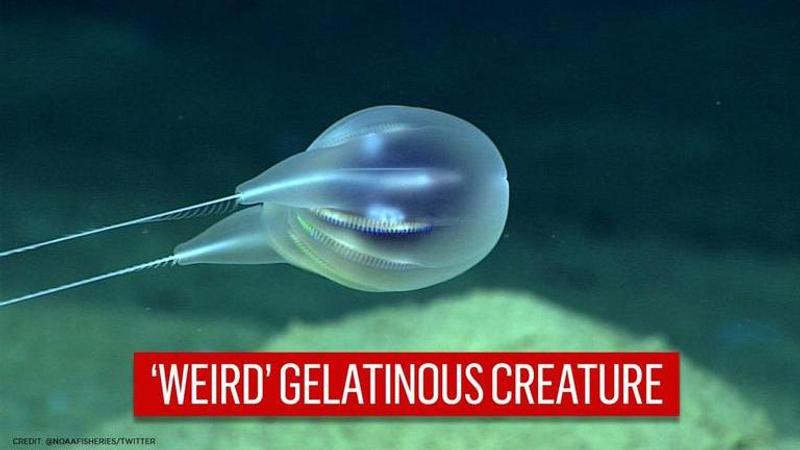Published 18:23 IST, November 29th 2020
'Looks like party balloon': New species of 'gelatinous' comb jelly found near Puerto Rico
Gelatinous creature with 'party Balloon-like' shape was spotted 2.5 miles in the ocean and was seen moving with two tentacles and a prism-like light effect.

Scientists at NOAA Fisheries research team on November 28 discovered a new species of ctenophore, or comb jelly, during an underwater expedition led by the NOAA Office of Ocean Exploration and Research. The newly termed Duobrachium Sparksae was detected near Puerto Rico by a remotely operated vehicle (ROV) known as Deep Discoverer. The weird-looking sea creature has ‘ a party balloon’ like shape and glistens as ‘transparent’. The “gelatinous animal” was spotted 2.5 miles down in a seafloor canyon and has been around in the oceanic flora and fauna for nearly 500 million years, according to Smithsonian National Museum of Natural History’s report.
In an official press release, the scientists at NOAA announced that a pulsating marine creature that created a “prism-like light effect” as it navigated through the oceanic currents was discovered. The Duobrachium Sparksae possessed at least eight rows of comb-like cilia that rhythmically beat, and refracted the light into colours while paddling, the NOAA informed. It added, that as many as 100–150 species of carnivores and highly efficient predatory species of comb jellies were discovered. They devour on small arthropods and sea larvae, scientists said. NOAA Fisheries scientists Mike Ford and Allen Collins were the first to spot the weird creature while working at the shoreside. A team of scientists used a high-definition video to annotate the newly found animal.
“It’s unique because we were able to describe a new species based entirely on high-definition video. The cameras on the Deep Discoverer robot are able to get high-resolution images and measure structures less than a millimeter,” Collins said in the release.
Collins added, “Footages gave enough information to understand the morphology in detail, such as the location of their reproductive parts and other aspects.” Meanwhile, the scientists informed that no physical samples of the creature were collected because “gelatinous animals don’t preserve very well; ctenophores are even worse than jellyfish.” High-quality video and photography were crucial for describing this new species,” Collins clarified, asserting that it was sufficient to make prominent details known.
Movement like a 'hot air balloon'
According to a statement by Mike Ford, the odd-looking ctenophore has long tentacles, and it was seen moving like a “hot air balloon” while it had two interesting tentacles attached to the seafloor that helped the creature to maintain a specific altitude above the seafloor. “It seems like the organism touches the seafloor,” Ford said, adding, “We’re not sure of their role in the ecosystem yet.” Scientists also believed that the species wasn’t “rare” as they encountered the species nearly “three times.” “I thought: that is so weird looking,” NOAA zoologist Allen Collins says in a video. “It’s like a party balloon, only instead of sort of having one string hanging down, it’s got two little dangly bits,” he said.
(All Images Credit: NOAA)
Updated 18:21 IST, November 29th 2020





